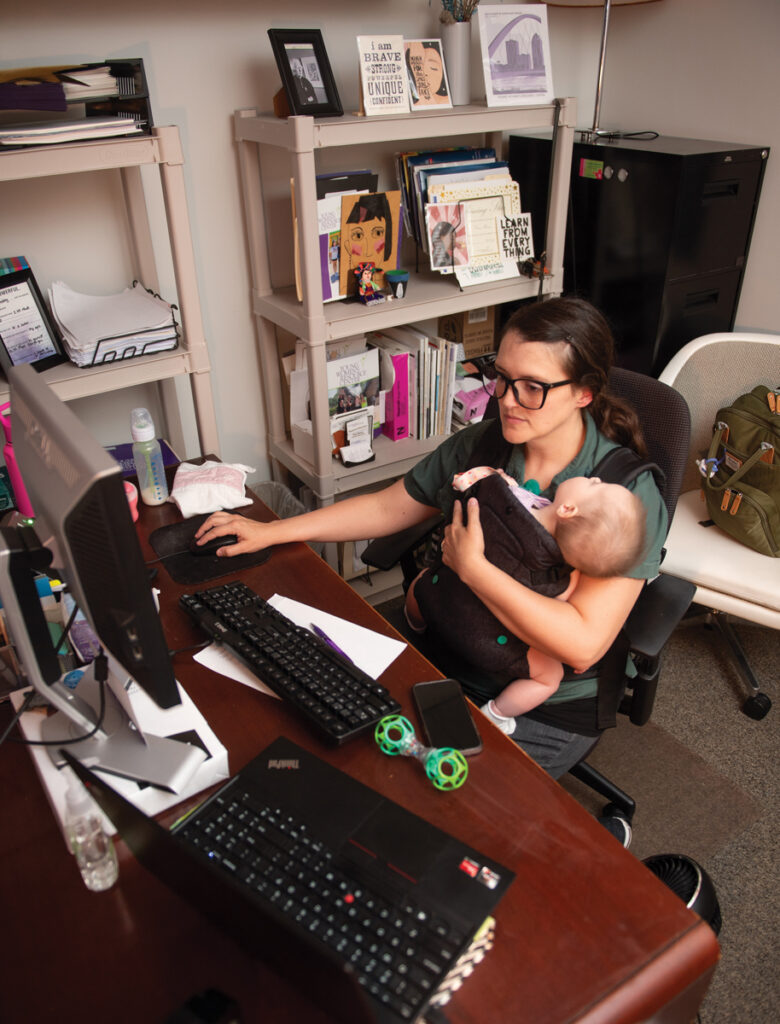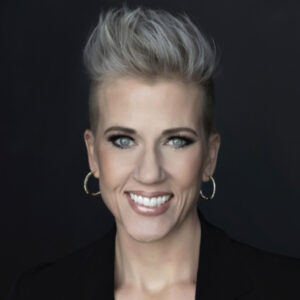As employers zero in on the health of their workers post-pandemic, more Central Iowa offices are welcoming babies

Infant-at-work policies improve retention, preserve institutional knowledge
It was time for Erin Moran to go back to work, with her baby daughter in tow as part of her workplace’s infant-at-work program.
The start was not auspicious.
“She had horrible gas, and acid reflux, and was screaming, and I thought, ‘Oh, no, I’m disrupting everyone. … This can’t be how this goes. How are we going to do this?’” said Moran, senior director of communications for the Young Women’s Resource Center in Des Moines. “I was very frazzled.”
Her colleagues made the difference, telling her that “‘babies are going to cry; we’re going to get this figured out, and it’ll be fine,’” Moran recalled. “I feel very grateful to my co-workers who came in, in a nonjudgmental and a very genuine way, saying, ‘How can I support you? It sounds like it might be a little bit rough right now.’ … It took away that fear of people thinking I wasn’t a good mom.”
After the COVID-19 pandemic, more Iowa employers are zeroing in on improving the mental and physical health of their workers.

For women, statistically, one of the most challenging mental health periods of their lives is the months after giving birth. Research by the U.S. Centers for Disease Control and Prevention shows about 1 in 8 women with a recent live birth reported symptoms of a postpartum mood disorder. Postpartum mood disorders can occur up to a full year after a person gives birth.
More Iowa workplaces, including the Young Women’s Resource Center, are using an innovative solution that can improve the health of new parents and their infants: Why not invite the babies into the office, at least for a while?
The employers are able to retain employees who might have quit, taking their institutional knowledge with them. The women are able to remain in the workforce, saving for retirement and working toward their career goals – there is no “broken rung” climbing the corporate ladder due to a long caregiving break. It’s a scenario that happens to countless new mothers.
Caregiving meant 5 years out of the paid workforce

Michelle Book was one of those new mothers in the mid-1980s. Book is now the CEO of the Food Bank of Iowa. But decades ago, living on a farm outside Atlantic, Iowa, during the height of the Farm Crisis, her family counted on her income from her job at an Omaha hospital, about an hour commute. “Back in those days, it was hard to arrange to leave the office for a dentist appointment,” Book said. “The corporate culture really was [being] in your seat from 8 to 5.”
Book was an accountant and auditor, and her employer expected her to return to work not long after her first child was born. “I had arranged for an acquaintance in Atlantic to provide infant care for Whitney. … I knew she would receive good care,” she said. “I just absolutely, positively had to go back to work because we needed my income. I planned for it all along.”
The day came.
“My alarm went off. I went to the shower. I’d packed my lunch the night before. I’d packed the diaper bag the night before. I had my clothes laid out so I could be efficient,” Book said. “I showered. I dried my hair. … I dressed. I was drinking my coffee.
“And I just remember putting my coffee cup down on the counter and just went to the couch, slumped on the couch, and I just sobbed. I sobbed and Whitney had woken up by then, and I think I was holding her, and I was sobbing, and then she became upset. And I just looked into that little face. … Nobody was there but Whitney and me, and I just said, ‘I can’t do this.’”
Book quit her job after she and her husband decided they could figure out a way to manage. They were working to expand their farrow-to-finish hog operation. Instead of driving to Omaha, she drove the tractor, castrated pigs and kept the farm books – she’d graduated from Iowa State University and had expertise in business administration and accounting. “But also, it was five years that I put my career on hold,” she said.
Her children were 5 and 2 when she eventually got a new job at the Cass County Memorial Hospital in Atlantic.
Over 30 years later, the Food Bank of Iowa is helping offer a different solution for parents, an infant-at-work program.
Book posted about it recently on LinkedIn, including part of the story about her children’s early years. Ellis Lowe just joined the Food Bank, the fifth baby in a little over three years to come to the office. “He gets a name tag, he gets a graduation certificate. He is part of the crew here,” Book said.
The workplace leaders interviewed by the Business Record for this story said the babies seem to improve everyone’s morale.
Where it all started

Girl Scouts of Greater Iowa is often mentioned as the first or one of the first local employers to pioneer the infant-at-work idea. CEO Beth Shelton said a lot of work had been done before 2018 on improving culture and internal support for a little over 50 full-time local employees. And then, “we had a lot of employees who happened to be pregnant all at once,” she said.
One woman came to Shelton and asked whether she could eventually bring her baby to the office while she worked. “And in my head, in that moment, I was like, ‘Hard no, absolutely not. Have you ever met a human child?’ … But I didn’t say that. I’ve learned a little bit in leadership about pausing and listening. I listened, I heard her out. And even after our meeting, I was like, ‘This is crazy. There’s no way we could have babies at work,’ but I said, ‘Let me reflect on that a little bit.’”
She researched motherhood’s contribution to the gender pay gap and logistics for how it might work to bring in babies.
“Within 24 hours, I had done a complete 180,” she said. Leaders started thinking about what it would take to make the idea a reality: “Where would you put diapers? What if it’s disruptive? How long could children cry? Where do you put them? And I’m like, ‘Well, let’s make a list of everything we would have to address.’ And we started doing that. So today we have a 12-page document that outlines all of those kinds of questions: Who can hold them? How long can they cry? Where do diapers go? What if it’s a colicky baby? All of those things. All of the proper liability of who can hold them and when. What if they’re sick? In January of 2019, the first baby came, the first of eight in a row.”
It’s been five years, and the 21st baby came to the Girl Scouts office earlier this month. The Girl Scouts have shared its infant-at-work policy with other Central Iowa employers as interest in the approach has gained steam.
Girl Scouts employees also get 12 weeks of paid parental leave. Babies can come in after that until age 6 months. “We have shared the policy, oh gosh, probably 300 or 400 times,” Shelton said. The Girl Scouts got helpful tips at the outset from a Kansas City insurance association that’s had a similar policy for two decades, Shelton said.
Shelton, too, said she’s grateful to provide an option that wasn’t available to her early in her tenure at Girl Scouts of Greater Iowa: “Being an executive female and having a baby was so challenging. This was before we had the policy.”
People shouldn’t assume that only narrow categories of employers can provide the flexibility to welcome infants, Shelton said.
“Come visit us. You will see that it’s a real workplace,” she said. “We have cubicles and computers, and everyone’s working all day long. No one’s sitting around campfires – maybe our camp director who lives somewhere else – but I think there’s this notion that somehow nonprofits are not doing real work or something. In my case and most of the people I know, it’s the opposite.”
Planning and culture
Moran’s infant daughter is the third baby to spend time at Young Women’s Resource Center under its policy.
The policy sets clear expectations for workers, she said: “Flexibility and accountability are two very essential components of being able to be a full-time employee and a full-time caregiver.”
But that doesn’t mean that the experience is always a smooth ride.
“At first, I felt a lot of guilt of, ‘I’m not being a good enough employee, I’m not being a good enough mom.’ Which I think a lot of people probably feel,” Moran said. “So it made a big difference to have a workplace that was like, ‘Nonsense. Babies cry. This is what babies do.’”
Caring for an infant at work means a lot of logistics and planning, Moran said, including a baby carrier, safe sleeping space, a safe play area and room for changing diapers. Her office is small but meticulously planned – every space has a purpose. She often uses a soft-sided infant carrier to wear her baby while she works.
Like many workplaces, the Young Women’s Resource Center has had a hybrid work schedule, with Moran’s team in the office three days a week and working remotely two days. She had an extra day at home each week during the infant-at-work period.
Improved retention due to the program
Although Girl Scouts of Greater Iowa’s policies have been shared throughout the state, each organization tailors its rules and tools to match specific needs and resources.
“We didn’t have a set room when we first started this,” said Shelton, the Girl Scouts CEO. “We call it the quiet room now. We don’t have a lot of resources, and we were very limited on our square footage or infrastructure. And so we made a choice when one of our C-suite roles turned over and we had a vacant office … we said, ‘No, this is more important and we are going to convert this to be the quiet room.’”
One benefit of an infant-at-work program for employers can be improved retention. Shelton and Book said they’ve seen good results at their workplaces.
Helping somebody along as they continue to bond with a child and recover from childbirth benefits everybody, Shelton said: “This policy is here to support that new parent or caregiver. And the expectation is not that the employee is performing at 100%. …
“When you can show someone a little bit of grace for being human for those three months, the payoff is incredible, not only for them personally, but for the organization. This is not a forever thing. So if someone’s performing at 85% for three months … is that really going to be detrimental, or could we find a way to accommodate for that?”
Book said her experience with her own children contributed to wanting to have formal assistance at the Food Bank of Iowa office. She and her staff explored setting up a child care facility at the office, but it would have been cost-prohibitive.
The Des Moines office has a lactation room with a sofa and a comfortable chair and appropriate lighting. “It really hasn’t bothered anybody else there in the five babies that we have sponsored; there’s never been a complaint,” Book said.
Babies can stay at the Food Bank of Iowa office until they’re 6 months old or until they’re mobile, whichever comes first.
The concept is a win for everybody, Book said: “I would just encourage other Central Iowa leaders to be open-minded, to take a look at it.”


